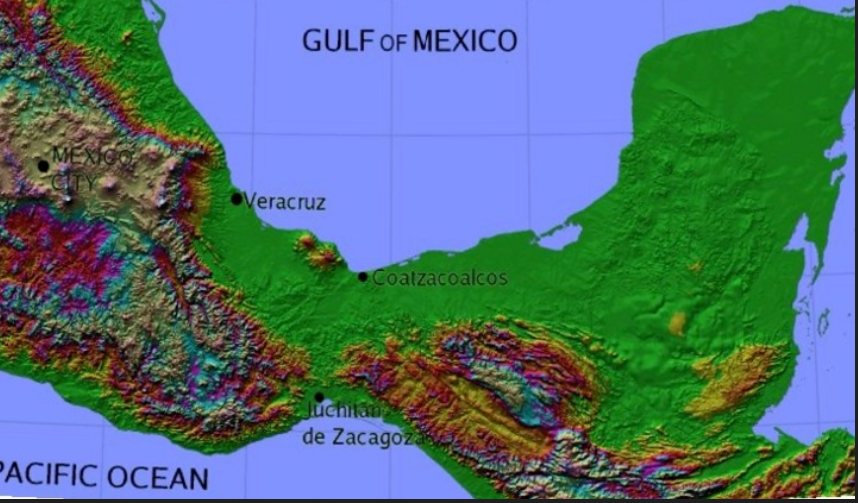The Interoceanic Corridor of the Isthmus of Tehuantepec will interconnect the Southern Mexican ports of Coatzacoalcos and Salina Cruz. It will impact the movement of goods and the economy with ten development poles along its 324 kilometers.
Through the Interoceanic Corridor of the Isthmus of Tehuantepec (CIIT), the current administration of Manuel Andres Lopez Obrador seeks to improve and accelerate the passage of goods of all kinds between the Pacific Ocean and the Gulf of Mexico.
The project, promoted by the Mexican federal government, proposes modernizing the ports of Salina Cruz, in Oaxaca, and Coatzacoalcos, in Veracruz, and rebuilding and modernizing the infrastructure that interconnects them. The project will directly or indirectly impact 79 municipalities: 46 in Oaxaca and 33 in Veracruz.
The Institutional Program, published on July 3 in the Official Gazette of the Federation, details that the main objective of the corridor is to “consolidate itself as a promoter and coordinator of public policies and national activities focused on the economic and social development of the region with objectives and strategies that seek to promote economic reactivation, the internal market and employment.”
According to President Andrés Manuel López Obrador, the highway currently being built is on the road route that has connected both ports for decades. It is expected to be ready in December.
In addition, the railway linking both ports on the Interoceanic Corridor of the Isthmus of Tehuantepec is being reconstructed, and the creation of 10 industrial parks along 324 kilometers is being promoted.
More than a railway
The Interoceanic Corridor of the Isthmus of Tehuantepec is a comprehensive project that includes:
- Industrial parks.
- Development and innovation poles.
- Free zone of the Isthmus of Tehuantepec.
- Merchandise transport.
After many years of attempts, the Federal Government launched a vast infrastructure project to accelerate the passage of all types of merchandise between the Pacific Ocean and the Gulf of Mexico.
One of the most relevant projects of the current administration contemplates improving and accelerating the passage of goods of all kinds between the Pacific Ocean and the Gulf of Mexico, an aspiration of the Mexican government for centuries.
This is the Interoceanic Corridor of the Isthmus of Tehuantepec (CIIT), a project promoted by the federal government, which aims to modernize the ports of Salina Cruz, in Oaxaca, and Coatzacoalcos, in Veracruz.
There is a distance of 324 land kilometers from port to port, and it currently takes about six hours to travel by land from one to the other.
The roadway currently being built is on the highway route that has linked both ports for decades. However, it is a new asphalt strip with better features for transporting heavy trucks and cargo.
In addition, the railway linking both ports on the Interoceanic Corridor of the Isthmus of Tehuantepec is being reconstructed. It will be essential for the transfer of all kinds of merchandise at a lower cost than by truck.
The train track will be essential because it will connect the interoceanic corridor with the Mayan Train, with a branch from Coatzacoalcos to Palenque.
In addition, the train is expected to have a diversion to the border with Guatemala, going from Salina Cruz along the coast to Tapachula.
Renewed ports on the Interoceanic Corridor of the Isthmus of Tehuantepec
In addition to the modernization of land roads, the project also includes expanding the ports of Coatzacoalcos and Salina Cruz.
In Coatzacoalcos, the platforms of the port area have already been expanded, and the bottom of the port has been dredged to expand its draft and allow the arrival of larger cargo ships.
Currently, most activity is concentrated in the port of Salina Cruz.
A breakwater is being built to give the port more stability. It will be a vital port that will take a while to build in stages.
In Salina Cruz, work is also being done on the modernization of the refinery and the construction of a coking plant to process fuel oil and convert it into gasoline. Only in the refinery it is an investment of more than 100 billion Mexican pesos.
More industrial parks
The Mexican government launched the bidding contests for the ten industrial parks or development poles that will form part of the interoceanic corridor of the Isthmus of Tehuantepec, between Coatzacoalcos and Salina Cruz ports. There are ten parks along the entire strip of the isthmus, with an average of 300 hectares per park, with water, gas, and electricity.
The intention of the Mexican president is that, in the industrial parks, goods of all kinds can arrive, be processed, have value-added, and be dispatched to one of the two ports to transport them by road, train, and ocean conveyance to the markets of the United States, Asia, and America from the south.
Two power plants will be built to provide electricity for the project, and wind energy equipment will be purchased from the Spanish company Iberdrola.
From colonial times, a corridor was contemplated to go from the Pacific to the Gulf. The isthmus was the object of the desire of the United States government to create a fast passage between both ports. Still, its attention focused on the Panama Canal, which is now saturated.
Currently, President López Obrador asserts that the interoceanic corridor of the Isthmus of Tehuantepec will be an alternative to the overcrowded canal and an opportunity to reduce the economic and social backwardness of the Tehuantepec isthmus. Additionally, the project will reverse the deterioration that has prevailed for a long time in the region’s industrial sector.
According to a diagnosis included in the institutional program, “the root cause of this situation, described in very general terms, is the absence for an excessively long period of public investment in key areas for economic development. This includes the maintenance and development of infrastructure communications, transport and telecommunications, and the supply of electricity, water, public services and other inputs that industry requires.”
In order to explore opportunities for investment in Mexico, contact LATAM FDI.


